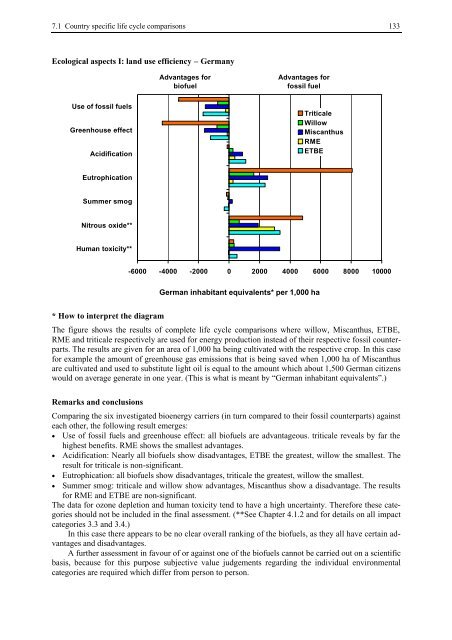BIOENERGY FOR EUROPE: WHICH ONES FIT BEST?
BIOENERGY FOR EUROPE: WHICH ONES FIT BEST?
BIOENERGY FOR EUROPE: WHICH ONES FIT BEST?
You also want an ePaper? Increase the reach of your titles
YUMPU automatically turns print PDFs into web optimized ePapers that Google loves.
7.1 Country specific life cycle comparisons 133<br />
Ecological aspects I: land use efficiency – Germany<br />
Use of fossil fuels<br />
Greenhouse effect<br />
Acidification<br />
Eutrophication<br />
Summer smog<br />
Nitrous oxide**<br />
Human toxicity**<br />
* How to interpret the diagram<br />
Advantages for<br />
biofuel<br />
Advantages for<br />
fossil fuel<br />
Triticale<br />
Willow<br />
Miscanthus<br />
RME<br />
ETBE<br />
-6000 -4000 -2000 0 2000 4000 6000 8000 10000<br />
German inhabitant equivalents* per 1,000 ha<br />
The figure shows the results of complete life cycle comparisons where willow, Miscanthus, ETBE,<br />
RME and triticale respectively are used for energy production instead of their respective fossil counterparts.<br />
The results are given for an area of 1,000 ha being cultivated with the respective crop. In this case<br />
for example the amount of greenhouse gas emissions that is being saved when 1,000 ha of Miscanthus<br />
are cultivated and used to substitute light oil is equal to the amount which about 1,500 German citizens<br />
would on average generate in one year. (This is what is meant by “German inhabitant equivalents”.)<br />
Remarks and conclusions<br />
Comparing the six investigated bioenergy carriers (in turn compared to their fossil counterparts) against<br />
each other, the following result emerges:<br />
• Use of fossil fuels and greenhouse effect: all biofuels are advantageous. triticale reveals by far the<br />
highest benefits. RME shows the smallest advantages.<br />
• Acidification: Nearly all biofuels show disadvantages, ETBE the greatest, willow the smallest. The<br />
result for triticale is non-significant.<br />
• Eutrophication: all biofuels show disadvantages, triticale the greatest, willow the smallest.<br />
• Summer smog: triticale and willow show advantages, Miscanthus show a disadvantage. The results<br />
for RME and ETBE are non-significant.<br />
The data for ozone depletion and human toxicity tend to have a high uncertainty. Therefore these categories<br />
should not be included in the final assessment. (**See Chapter 4.1.2 and for details on all impact<br />
categories 3.3 and 3.4.)<br />
In this case there appears to be no clear overall ranking of the biofuels, as they all have certain advantages<br />
and disadvantages.<br />
A further assessment in favour of or against one of the biofuels cannot be carried out on a scientific<br />
basis, because for this purpose subjective value judgements regarding the individual environmental<br />
categories are required which differ from person to person.

















